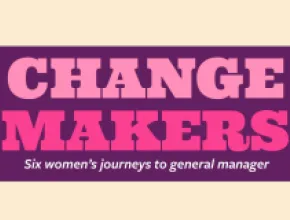Decor, especially when it really has a “wow” factor, can undeniably enhance an event, but it’s also an area where cost may potentially outstrip significance.
Here are some tips from veteran meeting planners about making a big impact with your decorating dollars, regardless the size of your budget.
Set Your Priorities
The first step is to determine how important decor is to the overall purpose of the meeting, and to make sure it doesn’t take precedence over other elements that deserve higher priority, says Amanda Miller, with the apt title director of details for The Place Setting Company in Fort Collins, Colo.
“When the budget is limited, it’s [beneficial] to take a step back and look at what’s really important,” she says. “When I work with clients, I always make sure a clear goal has been defined. And I reflect all purchasing decisions back to that goal. If it doesn’t connect with it, it’s not a necessary item.”
Miller adds that it can be all too easy to spend too much on peripherals at the expense of more important components such as the speaker or the room fee.
“The fun stuff is what clients often want to dive into, but that should be the last priority,” she says.
As much as he enjoys getting creative with event decor, Thomas Pitchford, principal and event planner with Pitch Perfect Events in Pasadena, Calif., agrees that it’s not the top budget priority.
“I always tell clients to not skimp on the cuisine—that it’s much more important than the decor,” he says. “Put more of your money toward cuisine and music.”
Pick the Right Venue
Perhaps the most effective way to save money on decor but still provide an engaging atmosphere is to choose a venue that doesn’t require much embellishment.
“If the venue already has great ambience, you don’t have to worry about bringing too many items in,” Miller says. “Try to think outside the box for a location. Look for a great view or a place like an artist’s studio.”
Lighting and Audiovisual
Pitchford places a lot of importance on the lighting possibilities that venues offer, which he says makes it possible to create atmosphere without driving up the cost.
“When clients are short on funds for a daytime event, I look for rooms with good natural light and plenty of windows where you can see trees or greenery outside,” he says. “For evening events, a room where you can control the lighting is great. You can create moods with lights just by adding a few up-lights or highlighting an accent wall.”
Christi Henderson, owner of Events by Chris in Livonia, Mich., agrees that lighting can save the day when the decor budget is sparse. One of her favorite techniques is “wall washing,” where up-lights are used to change the color of the room.
“You can use colored lighting to add warmth to a room or use it to tie in with the theme of the event,” she says. “For instance, at a travel-related event we used aqua to suggest water.”
While AV elements are not always thought of as decorative, event planners say they can go a long way toward creating visual excitement.
“Now there are so many more things that you can do to create atmosphere with AV,” Henderson says. ”You can have multiple screens with images off the computer or one large screen in the front that portrays the message you want to get across. The screens can be used as decor.”
Whenever possible, Pitchford likes to eliminate printing costs by using AV. For example, instead of menu cards for the tables, each meal course can be introduced on a screen.
“We start with projecting a slow word scramble, so that people can guess what the next course is before it is revealed,” he says. “The AV has already been paid for, so there’s no extra cost. It also gives you more flexibility than print when you have to make last-minute changes.”
PageBreak
Keep it Natural
When it comes to making a big impact for little money, event planners say natural elements such as plants, fruit, shells and stones are invaluable. While floral arrangements can be costly, renting indoor plants can be an affordable option, according to Miller.
“Plants really bring life into the room, which is helpful for creativity and productivity,” she says. “Whereas you can’t rent flowers, a lot of places will rent you plants.”
Henderson, who favors a casual approach to decor, says that it’s not necessary to get overly fussy or formal with flower arrangements.
“What we’ll do is use simple containers like mason jars with a piece of twine around them,” she says. “They look great with simple flowers, even wildflowers or flowers from the garden. You can also do centerpieces with tree branches for a very dramatic effect.”
Pitchford likes to use natural elements that tie in with the location or season.
“I believe in bringing the outside surroundings indoors; it gives people a sense of where they are,” he says. “For a beachside location, we might do a company logo in shells or sand. In the desert, we’ll rent pygmy palms and bring them into the ballroom. In wine country we’ll have items made of cork.”
A trick he’s learned to make floral arrangements less costly is to combine a mixture of artificial flowers with real ones. For instance, in a centerpiece he’ll put real flowers at the base, but have artificial ones higher up.
“It’s important to have the real flowers down where people will smell and touch them,” he says. “If you have artificial pieces further up, people will assume they are real. It can dramatically reduce the cost.”
Make a Statement
Bringing in one or two visually appealing items and placing them in key focal areas such as the welcome table is another good way to stretch the decor budget, according to Miller. She makes it a practice to keep a few pieces in her personal inventory that she can use repeatedly.
“You can make an effective sign with a sandwich board and chalk markers, so it’s very worthwhile investing in a few of these,” she says. “I have a beautiful bowl on a pedestal that I put at the welcome table for people to put their cards in. I also have a cupcake tower designed for a catering display where I might put pens and other business items instead. When you get creative, you can save a lot of money.”
Vendor Relationships
As in other elements of the meeting, vendor relationships are important when it comes to decor, according to Miller, who says keeping the number of vendors to a minimum saves on costs as each will have built-in charges for delivering items to the meeting. When appropriate, she also advocates negotiating sponsorship and trade opportunities with vendors.
“If the vendor has a reason for promoting their business at the event, they might supply what you need at a discount,” she says. “It could involve signage or allowing the vendor to give a spoken welcome.”
Miller also finds it cost-effective to cultivate repeat relationships with vendors.
“I have some great vendors that I work with repeatedly—I view them as my subcontractors,” she says. “Many will offer me an ongoing discount that I can pass along to my clients.”
MARIA LENHART has covered countless topics for Meetings Focus.







